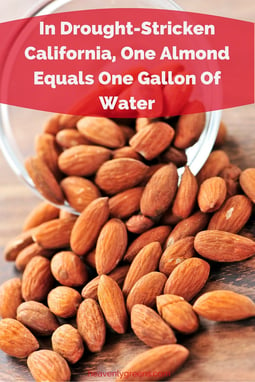 California is one of the hardest hit areas in the United States when it comes to drought conditions. Conditions are so bad that both state and local governments have enacted legislation prohibiting both businesses and residents from wasting the state's most precious natural resource. Violators can be charged heavy fines and penalties if they are caught misusing or wasting water. One of the biggest commercial users of water in the state are the almond farmers.
California is one of the hardest hit areas in the United States when it comes to drought conditions. Conditions are so bad that both state and local governments have enacted legislation prohibiting both businesses and residents from wasting the state's most precious natural resource. Violators can be charged heavy fines and penalties if they are caught misusing or wasting water. One of the biggest commercial users of water in the state are the almond farmers.
Farmers Vs Residents
In a state where residents are fined for wasting or misusing water, commercial almond farmers are defending their need to use exorbitant amounts of water to ensure a bountiful crop. Almonds require almost one gallon of water per nut/fruit to thrive. While residents must monitor how much water they use to brush their teeth or bathe, commercial growers are trying to justify using hundreds of gallons of water per tree every fourteen days. The argument between the two groups is a valid one, but it is also one that carries a hefty price tag.
Farmers are trying to protect their livelihoods. Residents are more concerned with the state's quickly diminishing water supply and how long it will last during the extreme drought conditions. One of the main complaints residents have is that the majority of the almond farmers' crops are shipped to foreign countries like China. While there are strict regulations in place that apply to both residents and agricultural farmers, the almond growers claim they are staying within state mandated limits for watering their crops.
Pros
Almonds are just one of many prime types of produce grown in California. The industry brings in millions of dollars each year. Farmers have had to alter their growing methods to accommodate the water usage restrictions that have been put in place by state government. Farmers and other commercial businesses, including those in agriculture, must comply with state regulations just like every other resident.
Growers and farmers who are able to comply with the state regulations and still maintain an active and productive operation help to boost the state's economy and support financial growth. Growers have started to use more organic methods in growing many of the state's cash crops, in an attempt to protect the local water supply. This means fewer toxic contaminants entering aquifers and ground water supplies.
Cons
The cons associated with almond farming primarily revolve around the industry's massive use of water. Almond farmers claim that it takes a gallon of water to produce one almond. With hundreds of almonds on a single tree, the math translates to a major water drain on the state's very limited, natural resource. While farmers have taken great strides in reducing the amount of toxic fertilizers and pesticides, the fact that the amount of water needed tends to negate the benefits in the eyes of many residents. Many farmers who have large almond groves are in a tough position. By reducing the amount of water they use to care for their trees, they are essentially limiting their own growth and productivity and cutting profits.
California residents want commercial farming operations and other commercial entities to follow stricter guidelines when it comes to water usage, even if it means cutting profits and losing business. State legislators are stuck in the middle, trying desperately to help residents resolve water usage issues, while at the same time allowing businesses to remain profitable and increasing the state's overall economy. Both sides have a long way to go before a mutually beneficial agreement will be reached. The problem is that each side believes they are right in their way of thinking leaving the issue at a hard fought stalemate.












